MARIANI’S
Virtual
Gourmet
August 16, 2015
NEWSLETTER
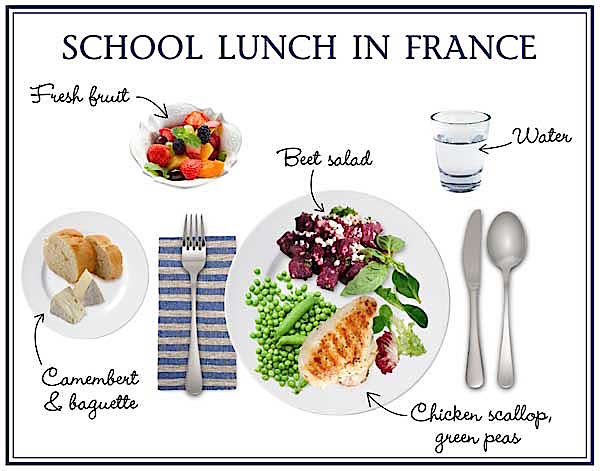
IN THIS ISSUE
MEMPHIS EATS
By John Mariani
NEW YORK CORNER
COSTATA
By John Mariani
NOTES FROM THE WINE CELLAR
A NEW VINEYARD BRINGS CHANGE
TO ROBERT MONDAVI WINERY
By Brian Freedman
❖❖❖
MEMPHIS EATS
By John Mariani
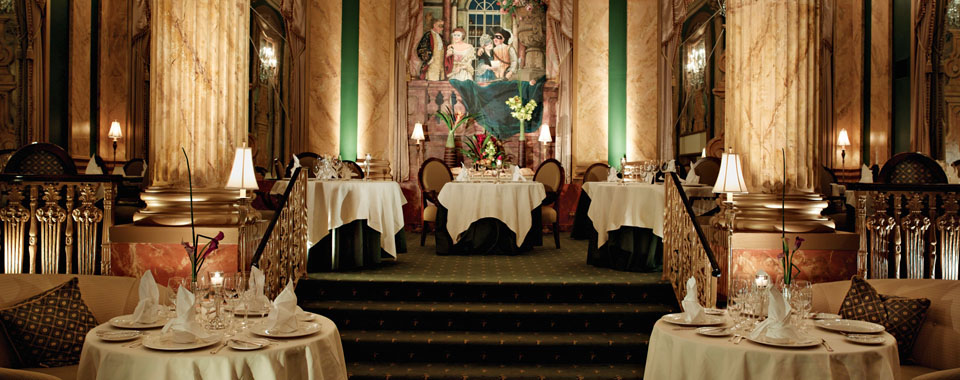
Chez Philippe at The Peabody Hotel
Does
one need to say more about Memphis eats than the
word “barbecue”?
If the food media had their way, that’s
about the extent of coverage they’d give this
wonderful, newly vibrant Southern city. And,
while there is indeed plenty of good ‘cue in town,
it is sheer ignorance to stop there.
Over the past five years Memphis, like many other
Southern cities, has grown diverse and global in
its food scene, while still maintaining an abiding
affection for the culinary heritage of the
mid-South.
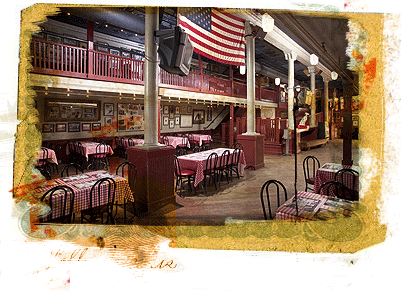 Just to get
barbecue out of the way, the one that still gets all
the legitimate publicity is Charlie
Vergos Rendezvous (left). Opened
in 1948, it is justly famous not only for its
celebrity clientele over the years--not least
musicians like Vince Gill, the Rolling Stones, Frank
Sinatra--but for the consistency of its
idiosyncratic style of dry-rubbed, un-sauced ribs.
They’re only open for dinner, but when the door
opens at midday they are kind enough to
pack some up for you for take-out. A combo
of ribs and pork will run you $19.75; a ham &
cheese sandwich (the first thing ever on the menu
here) is $10.95.
Practice has put perfection within their
grasp. They
also ship anywhere.
Just to get
barbecue out of the way, the one that still gets all
the legitimate publicity is Charlie
Vergos Rendezvous (left). Opened
in 1948, it is justly famous not only for its
celebrity clientele over the years--not least
musicians like Vince Gill, the Rolling Stones, Frank
Sinatra--but for the consistency of its
idiosyncratic style of dry-rubbed, un-sauced ribs.
They’re only open for dinner, but when the door
opens at midday they are kind enough to
pack some up for you for take-out. A combo
of ribs and pork will run you $19.75; a ham &
cheese sandwich (the first thing ever on the menu
here) is $10.95.
Practice has put perfection within their
grasp. They
also ship anywhere.
More traditional barbecue is
found at the award-winning Central BBQ,
which smokes all its own ribs,
pork, chicken, turkey, beef brisket, sausage and
bologna. As
at the Rendezvous, they cook the meats without
sauce, but four varieties are readily available in
bottles at your table. 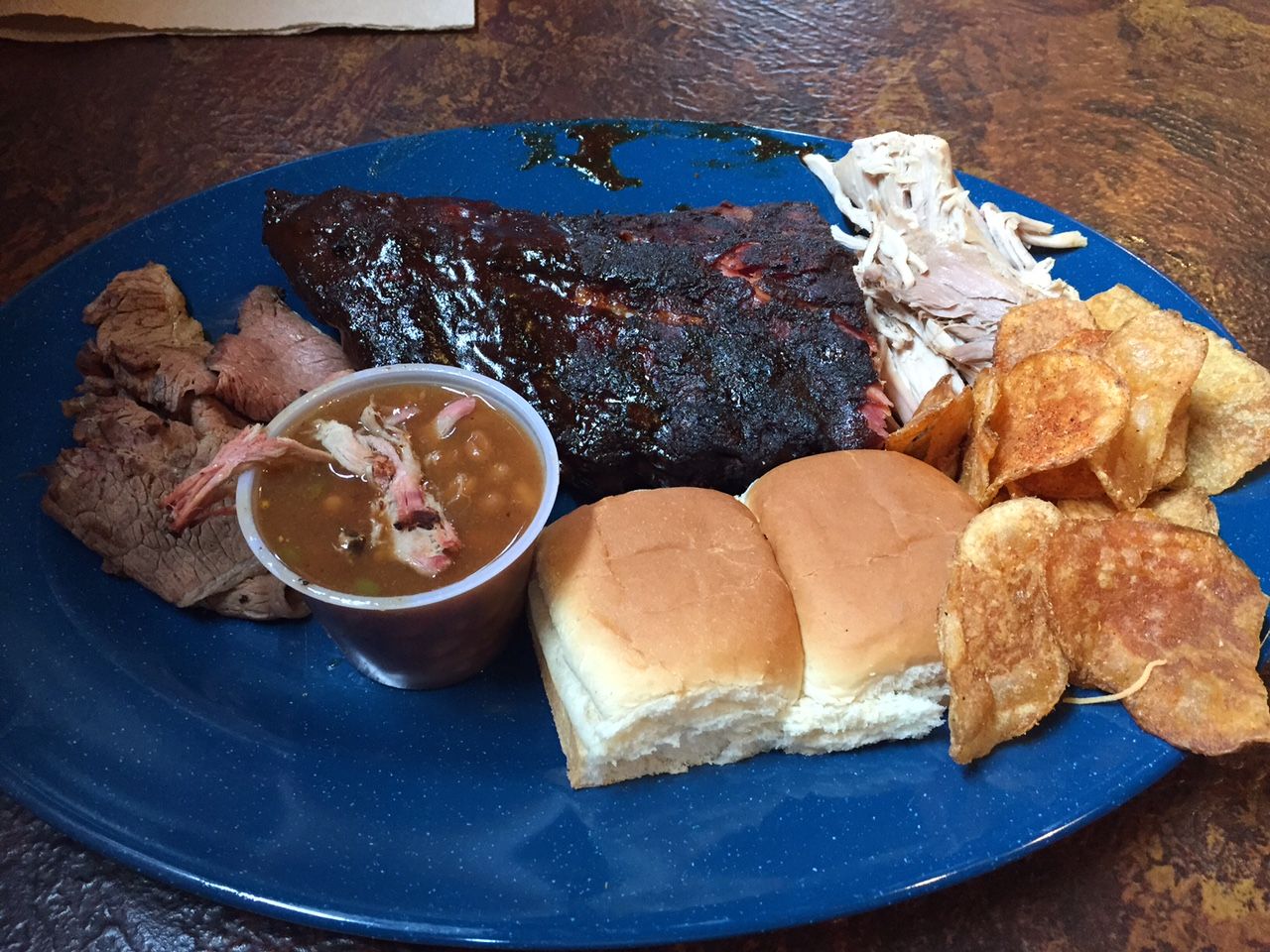
Central BBQ began after Craig
Blondis and Roger Sapp met on the BBQ competition
circuit in the mid-80s and became business partners
when the first store opened in 2002; there are now
three Central BBQ’s, the original in Midtown on
Central Avenue, where they also park a ‘cue truck
splashed with psychedelic colors. Needless to say,
lines start forming around 11 a.m. each day and on
Saturdays the rafters ring with the cries of fans
who come here to watch the University of
Memphis Tigers on the big TV screens.
Central has a big menu, from
excellent, subtly chewy, succulent ribs (half a slab
runs $15.99, full slab $22.99) and a pork plate
($9.99) to the much recommended combo plate ($18.99;
right).
There are also ‘cue sandwiches, including that
Southern favorite and acquired taste BBQ bologna
($3.99), along with hot wings ($5.99), nachos
($5.75) and a sausage and cheese plate ($9.99), not
to mention sides and huge desserts at very low
prices--hot fudge brownie and ice cream for four
bucks; you’ll need two forks.
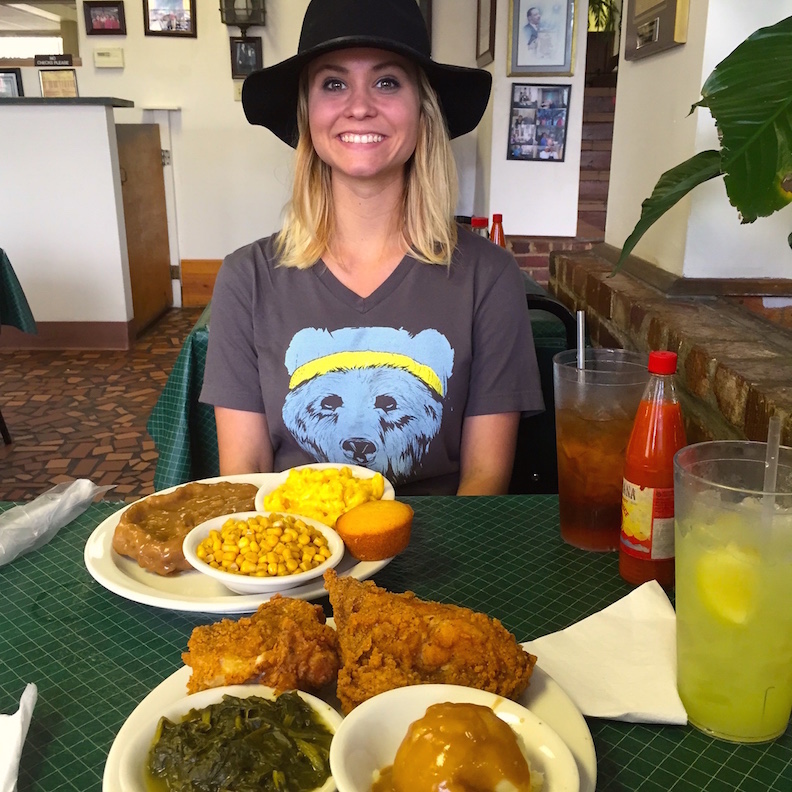 The
Four Way
Restaurant (left) has been the city’s go-to
place for soul food of the most satisfying
kind--very good and very cheap. Get owner Willie
Earl Bates talking about how the place started and
flourished, who’s eaten here, and how he doesn’t
think much about putting in 12-hour days and you
could be here for hours. The man loves to talk and is a
natural raconteur.
The
Four Way
Restaurant (left) has been the city’s go-to
place for soul food of the most satisfying
kind--very good and very cheap. Get owner Willie
Earl Bates talking about how the place started and
flourished, who’s eaten here, and how he doesn’t
think much about putting in 12-hour days and you
could be here for hours. The man loves to talk and is a
natural raconteur.
The neighborhood is run down now, but nothing
has changed inside the restaurant, which has fed
everyone for decades. You’ll see as many Cadillacs
and Lexuses in the parking lot as you will pick-up
trucks and old Datsuns. Black and white people dine
here together, everyone jammed in at tables that
might be occupied by Gladys
Knight and The Pips, Aretha Franklin, Tina Turner
and other stars of Memphis music.
The wait staff at Four Way is as welcoming as
the aroma of the fried chicken being cooked to
order. (White meat is $7.99, dark meat 50 cents
less.) Country
fried steak ($8.99) is big as a flattened football,
crisp and juicy, with a peppery milk gravy lavished
over it. Then there’s a big scoop of mashed
potatoes, mac-and-cheese, bitter, soupy collards,
and a good cornbread muffin. You’ll have to do with
lemonade or soda for a beverage. Prices
haven’t changed in three years.
Memphis has most any ethnic eatery you could
want, from sushi at
Bluefin
and Sakura (two
locations) to
Jamaican at Evelyn
& Olive.
I was taken to an delightful and very
colorful Venezuelan spot called Arepa &
Salsa, whose brochure offers a long,
fascinating history of the stuffed corn muffins (right) that
give the place its name. Start off 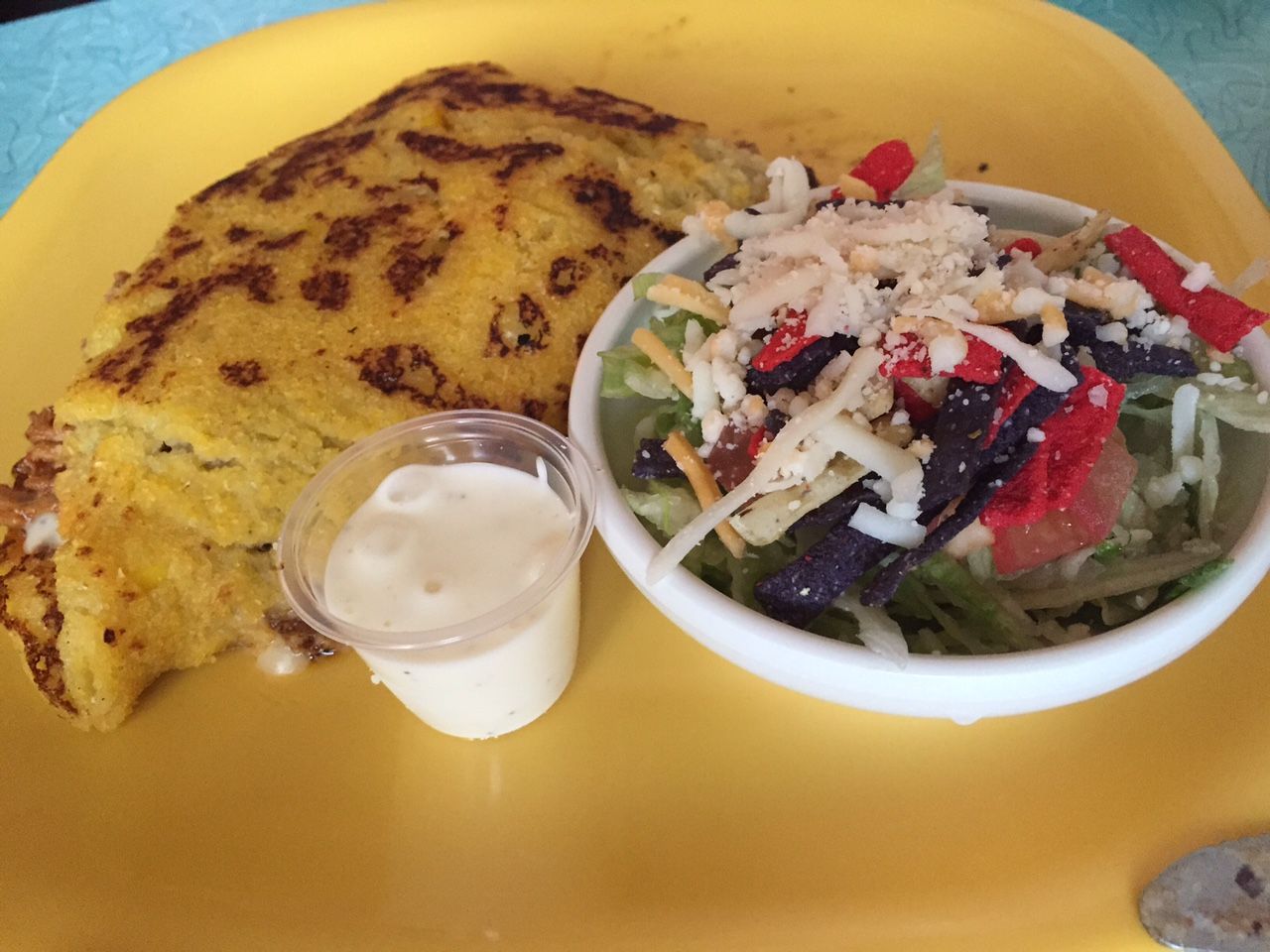 with empanadas
($6) or arepa
pernil with shredded seasoned pork ($8), then
pebellon
“Oscar D’Leon” with shredded beef, black
beans, cheese and fried plantain ($10). The food
is as pretty as it is delectable, and they have a
cut-out of Dos
Equis’ “Most Interesting Man in the World” to pose
with in the dining room.
with empanadas
($6) or arepa
pernil with shredded seasoned pork ($8), then
pebellon
“Oscar D’Leon” with shredded beef, black
beans, cheese and fried plantain ($10). The food
is as pretty as it is delectable, and they have a
cut-out of Dos
Equis’ “Most Interesting Man in the World” to pose
with in the dining room.
At the other
end of Memphis’s dining scene is Chez
Philippe, the beautiful,
marble-pillared, gilded, three-level restaurant at
The Peabody Hotel, and for many decades now one of
the grandest rooms in the South, with an unstinting
commitment to haute cuisine, now under Executive
Chef Andreas Kisler, who is not above adding modern,
global flavors.
Start off with a cocktail in the
Lobby Bar--you just might catch the famous Peabody
ducks coming out of the marble fountain and waddling
toward the elevators. Then go up a few steps into
the stately, richly appointed dining room, where you
will definitely be pampered with the best linens,
silverware, and service with a distinct Southern
gloss. Three
courses are $80 ($34 more with wine); a five-course
tasting menu is $105 ($46 more with wine).
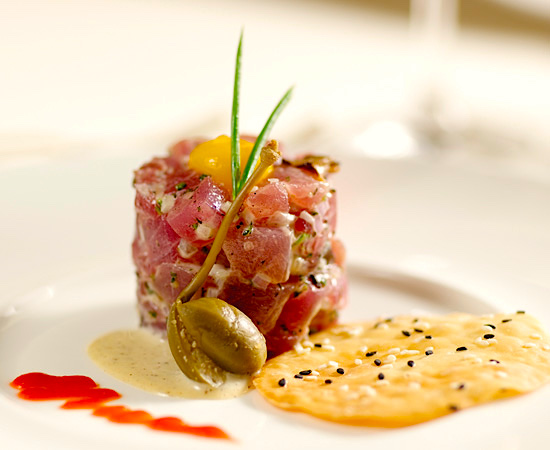 Kisler’s is a
sumptuous cuisine, evident in a dish like his
pan-seared pheasant with braised Brussels sprouts,
mixed dried berries and a truffle Peruvian potato in
cassis sauce.
A seared crab cake comes with barley, sweet
potato and an orange-green peppercorn butter sauce. There are
sometimes one or two too many items on a plate, but
I’m not going to argue with a superb dish like the
lamb chop and braised lamb shank set in a
profiterole with baby garbanzo beans tapenade,
purple potato croquette and roasted garlic jus. The
French onion soup needs more caramelization and a
more deeply flavored broth. Desserts,
as you can imagine, are extravagant, from a trio of
crème brûlées to the Peabody’s signature Equinox
Cake, a chocolate-hazelnut torte with gianduja
brûlée center.
Kisler’s is a
sumptuous cuisine, evident in a dish like his
pan-seared pheasant with braised Brussels sprouts,
mixed dried berries and a truffle Peruvian potato in
cassis sauce.
A seared crab cake comes with barley, sweet
potato and an orange-green peppercorn butter sauce. There are
sometimes one or two too many items on a plate, but
I’m not going to argue with a superb dish like the
lamb chop and braised lamb shank set in a
profiterole with baby garbanzo beans tapenade,
purple potato croquette and roasted garlic jus. The
French onion soup needs more caramelization and a
more deeply flavored broth. Desserts,
as you can imagine, are extravagant, from a trio of
crème brûlées to the Peabody’s signature Equinox
Cake, a chocolate-hazelnut torte with gianduja
brûlée center.
What La Grenouille is to New
York, The French Room is to Dallas and Commander’s
Palace is to New Orleans, Chez Philippe is to
Memphis and proudly so.
Chez
Philippe’s former Maîtres Cuisinier, José Gutiérez (below), took
over the restaurant River Oaks in
the ‘burbs, and it is representative of the modern
style of international restaurant Memphis is now
acquiring. With its shadowy, 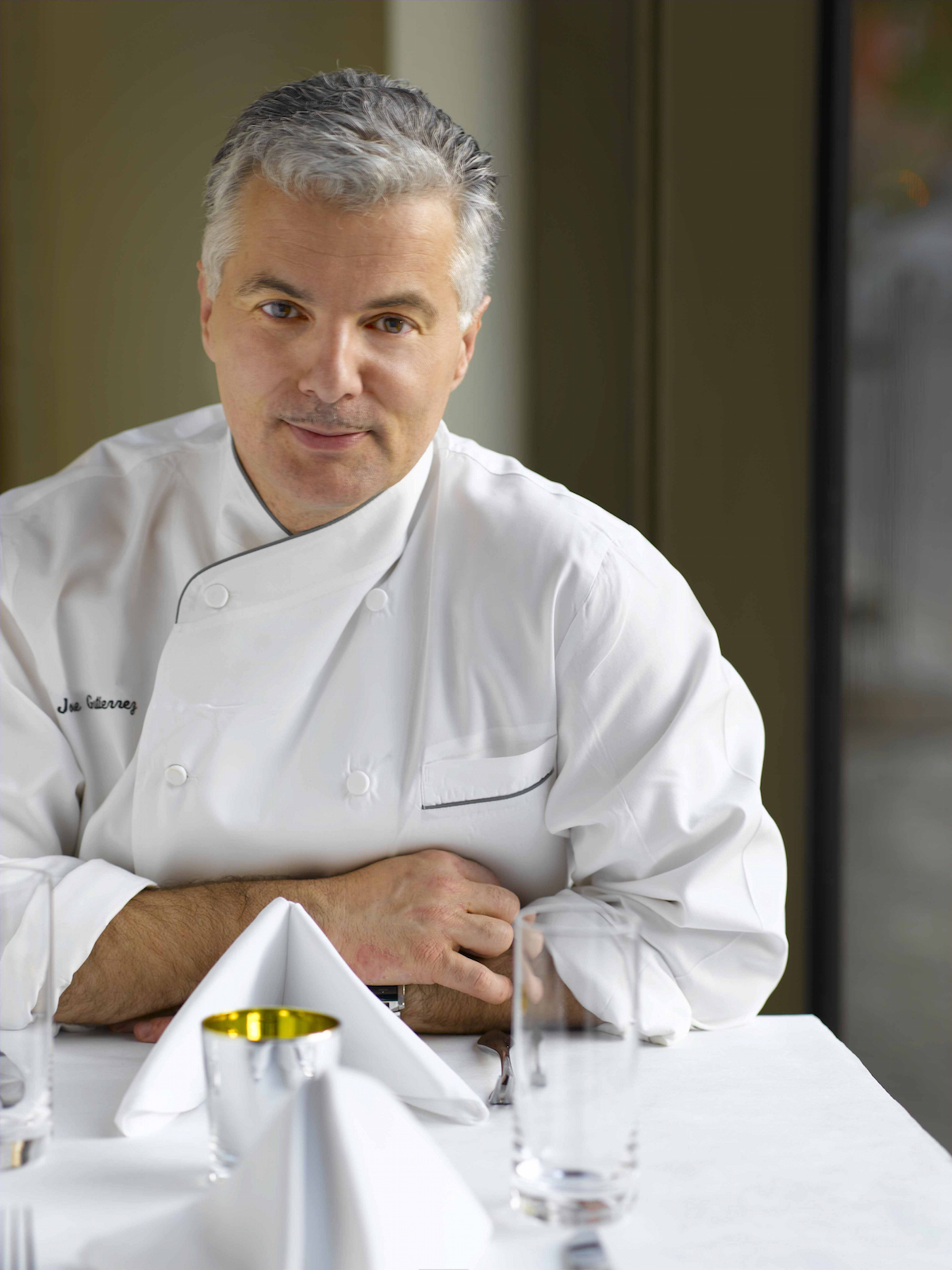 relaxed
ambiance and murals by local artists, the dining
room gets a cross-cut crowd of people who may enjoy
a cocktail at the bar (below) before letting the ever
jolly Gutiérez tell them the specials. His fried
crab cakes ($17) are truly made with jumbo lump
meat, and Gutiérez’s French background shows off in
a textbook perfect duck confit with house-made
fettuccine ($26).
In such a place I would not usually order a
burger, but Gutiérez swore I would love it and he
was right. It’s a glory, with bacon bits on a crusty
roll and hot pommes
frites that deserve to retain their French
name, and a choice of cheeses, caramelized onions,
or even an egg on top ($15).
relaxed
ambiance and murals by local artists, the dining
room gets a cross-cut crowd of people who may enjoy
a cocktail at the bar (below) before letting the ever
jolly Gutiérez tell them the specials. His fried
crab cakes ($17) are truly made with jumbo lump
meat, and Gutiérez’s French background shows off in
a textbook perfect duck confit with house-made
fettuccine ($26).
In such a place I would not usually order a
burger, but Gutiérez swore I would love it and he
was right. It’s a glory, with bacon bits on a crusty
roll and hot pommes
frites that deserve to retain their French
name, and a choice of cheeses, caramelized onions,
or even an egg on top ($15).
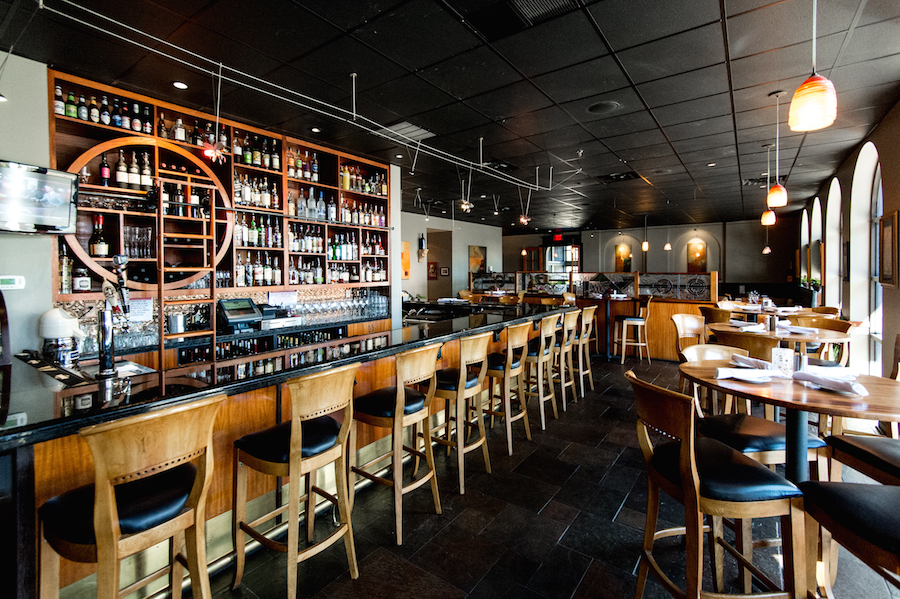 The
crème brûlée ($7) here is as good as you’d expect,
and don’t miss the warm “Mojo” chocolate chip cookie
with ice cream ($12), easy enough to share. The wine
list is not extensive but does the job and prices
are very fair.
The
crème brûlée ($7) here is as good as you’d expect,
and don’t miss the warm “Mojo” chocolate chip cookie
with ice cream ($12), easy enough to share. The wine
list is not extensive but does the job and prices
are very fair.
Some
of the best Italian food I’ve had in the South is
being done by boyhood friends Andrew
Ticer and Michael Hudman, whose Italian
grandmother’s Sunday dinners were the inspiration
for their Andrew Michael
Italian Kitchen (below). They
also run the acclaimed Italian-Southern restaurant Hog &
Hominy across the street, and their cookbook
is appropriately titled Collards
& Carbonara. Both studied under José Gutiérez at
Chez Philippe, so their technique is solid, and they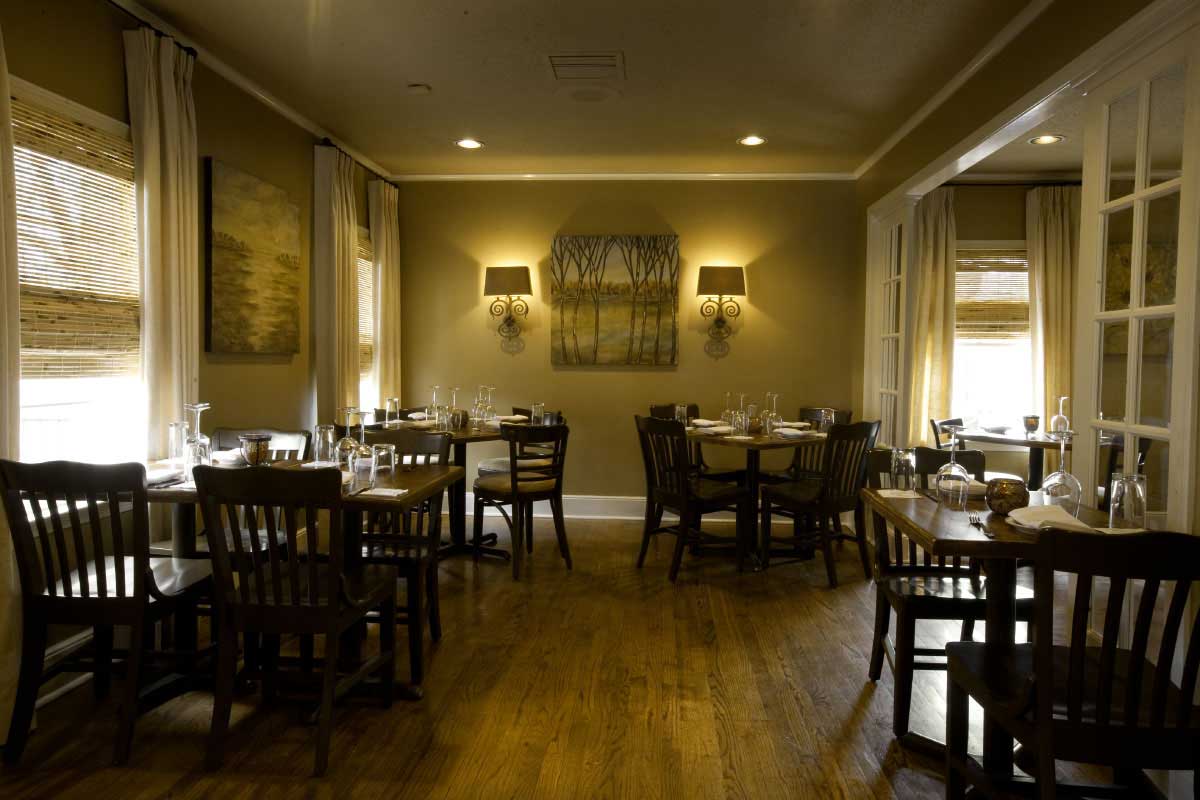 understand
that Italian food should never be overly elaborate
or showy. So,
while their personal stamp is everywhere on the
menu, it all hearkens back to “Maw Maw’s Ravioli”
with tomato sauce ($10).
understand
that Italian food should never be overly elaborate
or showy. So,
while their personal stamp is everywhere on the
menu, it all hearkens back to “Maw Maw’s Ravioli”
with tomato sauce ($10).
Opened in 2008, AMIK (I’ll call
it) segments its menu into antipasti, which includes
a very good chicken liver parfait on a generous
charcuterie plate ($15); starters, with a delicious
dish of leeks, romesco dressing, straciatelli of egg, red onion and pecorino ($11);
and pasta, with stand-outs like the agnolotti with morels, peas, black truffles,
tarragon and lemon ($14) and bucatini with a short rib ragù, taleggio,
Serrano chiles, shiitake and breadcrumbs ($11).
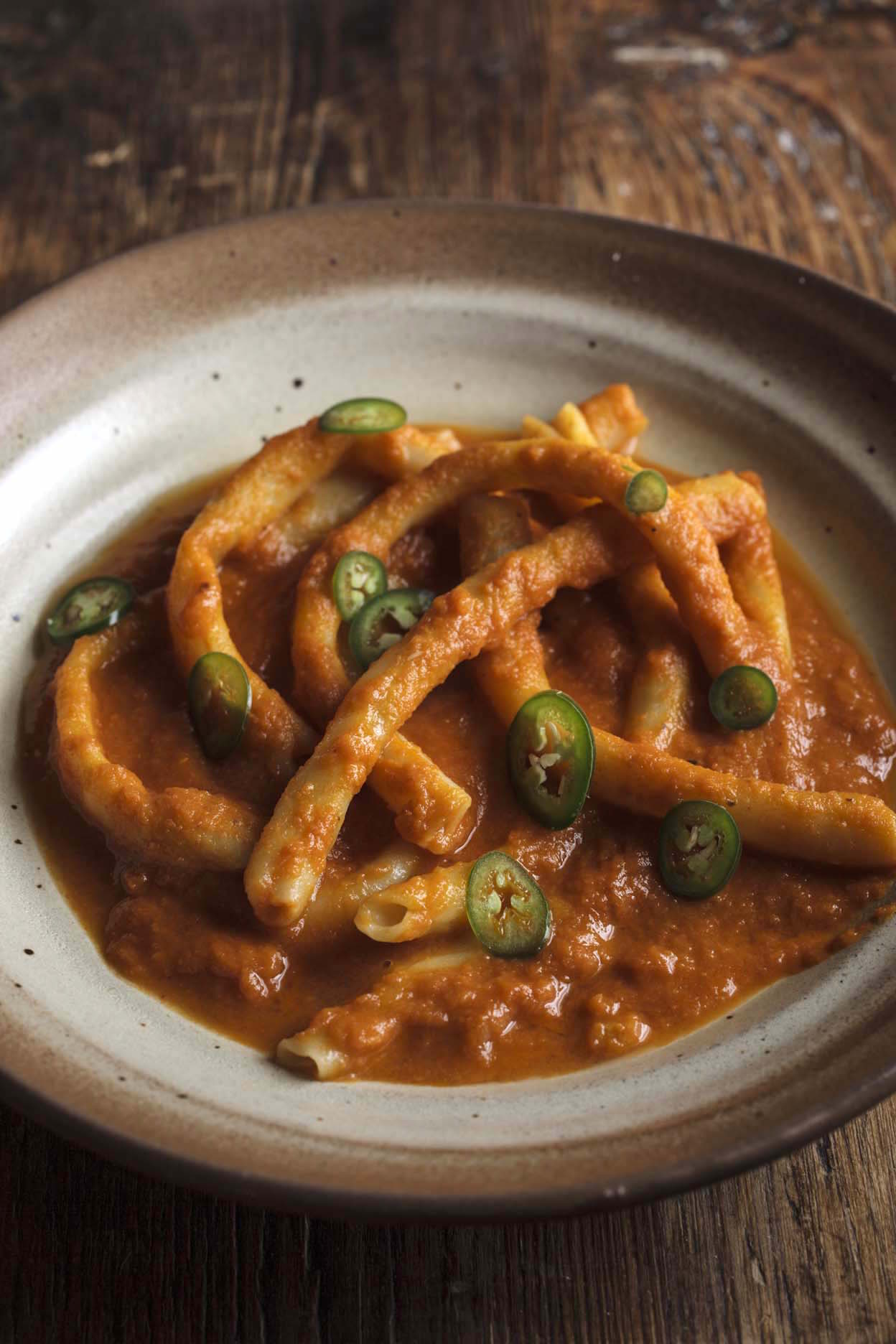 Sorry, but Maw Maw’s ravioli
didn’t live up to my expectations, and entrees were
not quite as wonderful as what precedes them. I
would recommend the pork with fennel, passatelli,
ramps, pancetta
ham, radish and red peas ($29), though its
aggregate of ingredients goes against the Italian
idea of simplicity.
Sorry, but Maw Maw’s ravioli
didn’t live up to my expectations, and entrees were
not quite as wonderful as what precedes them. I
would recommend the pork with fennel, passatelli,
ramps, pancetta
ham, radish and red peas ($29), though its
aggregate of ingredients goes against the Italian
idea of simplicity.
I loved three desserts I tried (all $7) from
a very good, crisp and creamy cannoli to an
irresistible chocolate sticky pudding and a
perfectly rendered budino pudding with chocolate, salted caramel
and toffee.
Oh, and if you ask them nicely to
turn down the wholly unnecessary loud music, they
will.
Although I wish I’d gone for
dinner, I was able to have a sumptuous brunch at the
10-year-old Majestic Grille (right)
on premises built in 1913 as Majestic No. 1 movie
house in a gorgeous Beaux Arts style that took on a
lot of art deco.
Chef-owner and Irishman Patrick Reilly and
his wife, Deni, have maintained a 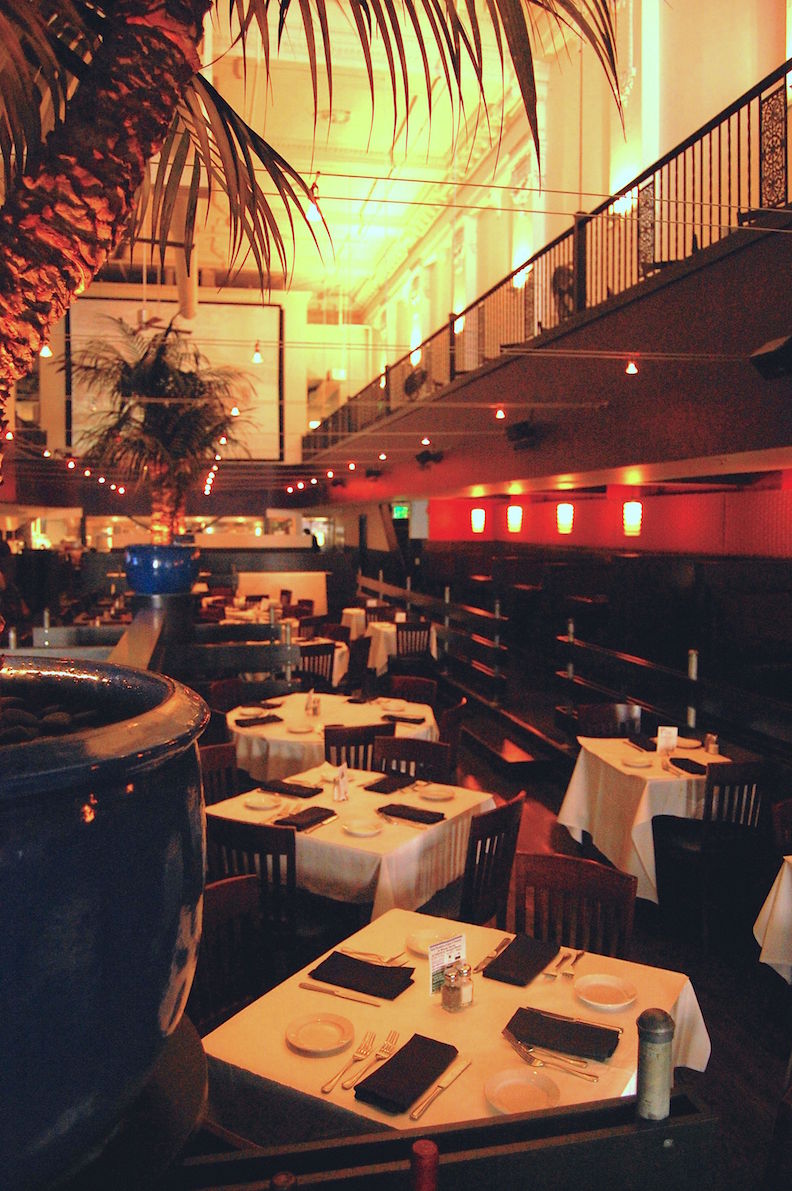 movie screen in the
two-tiered restaurant showing silent films, and the
restaurant has won just about every award possible
from the local and regional press. There are
usually lines outside waiting for a table on
weekends, and on Sunday people tend to dress as if
they have just come from church service or are on
their way to their country club. There's a lot
of sweet iced tea on tables but also a lot of
Champagne from an excellent list.
movie screen in the
two-tiered restaurant showing silent films, and the
restaurant has won just about every award possible
from the local and regional press. There are
usually lines outside waiting for a table on
weekends, and on Sunday people tend to dress as if
they have just come from church service or are on
their way to their country club. There's a lot
of sweet iced tea on tables but also a lot of
Champagne from an excellent list.
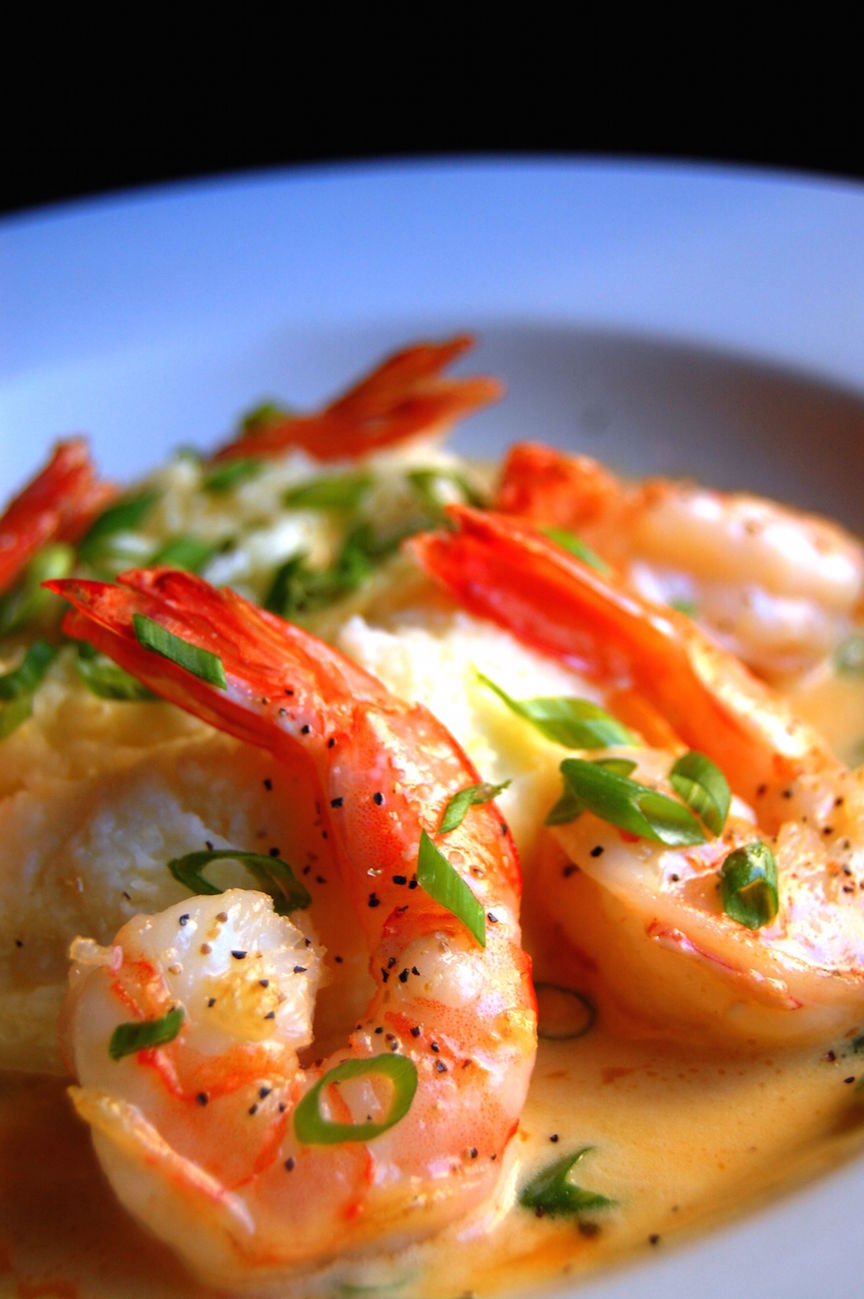 The brunch
menu is huge, from house-smoked salmon ($10) and
cornmeal crusted calamari ($9) to their signature
flatbreads ($10-$12), sandwiches and burgers. And
the specialties include thick-cut French toast with
bacon and strawberries ($12), jumbo shrimp (left) sautéed
in plenty of garlic with cheddar cheese-rich grits
($15), biscuits and gravy ($9), and much more. Generosity
is the key word to what's on every plate.
The brunch
menu is huge, from house-smoked salmon ($10) and
cornmeal crusted calamari ($9) to their signature
flatbreads ($10-$12), sandwiches and burgers. And
the specialties include thick-cut French toast with
bacon and strawberries ($12), jumbo shrimp (left) sautéed
in plenty of garlic with cheddar cheese-rich grits
($15), biscuits and gravy ($9), and much more. Generosity
is the key word to what's on every plate.
Everything I
tasted I knew was made from the best ingredients
Reilly can procure and all were cooked with a sure
degree of attention to textures, not to mention the
kind of largess that Memphis is famous for. Brunch
was packed, the flow of food was easy, and it was
clear that everyone was going to stay on longer than
they’d planned, maybe for another Bloody Mary.
❖❖❖
By John Mariani
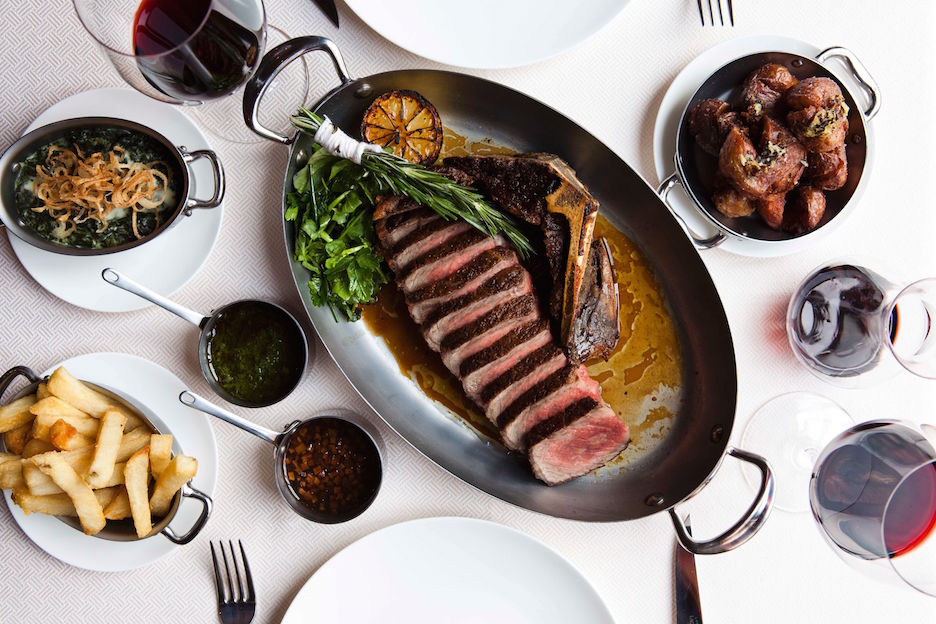 COSTATA
COSTATA
206
Spring Street (off
the Avenue of the Americas)
212-334-3320
costatanyc.com
Tweaking is as important
to a serious restaurant as tuning is to a
violin.
So, after opening two years ago, Costata
is now a better restaurant for
the changes that have been made to the
three-story premises, which include
better lighting, more colorful artwork and a far
more affable service staff.
Costata is very much in the
tradition of the
New York Italian Steakhouse, a genre pioneered
in 1926 at the first Palm (now
undergoing a “major facelift”), whose raffish
atmosphere, barebones look, and
menu of steaks, lobsters, tomato salad, a few
pastas and cheesecake defined the
idea, replicated at its nearby competitors
Christ Cella, Colombo’s, Pietro’s,
Joe & Rose’s and Bruno’s Pen & Pencil. That template is still in
effect on scores of contemporary
steakhouses, although these days new entries
tend to be far more swank, and
Costata falls into that category.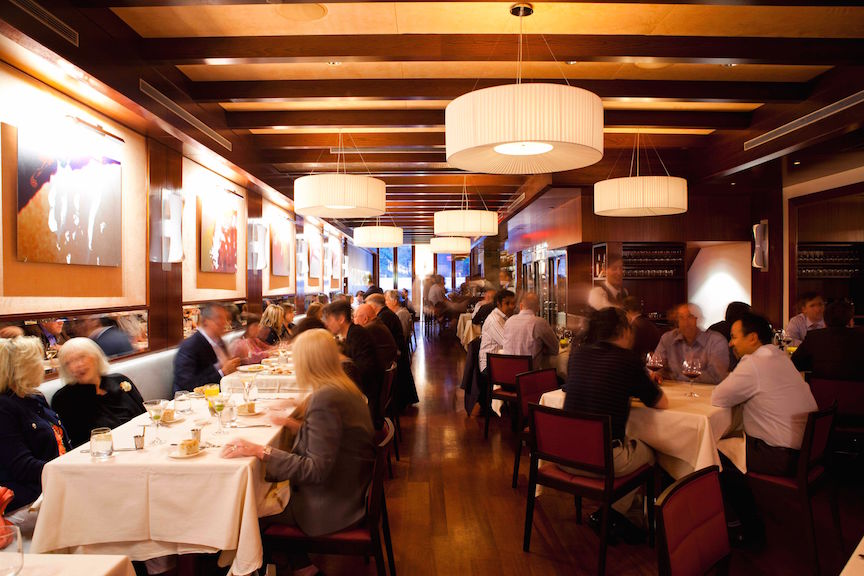
The new artwork at Costata is
by London-based
artist Nasser Azam, with sixteen
installations, including large abstract
paintings and prints on aluminum
and mirror. Hardwood floors are buffered
by softer elements, and it’s
good to see double tablecloths and good lighting
(though they dim it
mid-evening). The music, though unnecessary, is
not all that intrusive.
The
36-page
wine list is exemplary, though pricey: a
Trebbiano d'Abruzzo Emidio Pepe 2007
by the glass is $36; a bottle at the store is
$65. But the number of older
vintages of top labels makes this screed very
impressive indeed.
Costata is part of
chef/restaurateur Michael
White’s Altamareagroup empire, which now extends
to Marea, Morini Trattoria,
Morini Ristorante, Ai Fiori, and The Butterfly,
all in New York; Due Mari in
New Brunswick, NJ, two Nicoletta pizzerias;
Bedford Post Inn in Bedford, NY;
Chop Shop in London; and Al Molo
in Hong Kong.
Costata is something
of a homecoming for White, who
first established his rep as chef in these same
Soho premises when it was
Fiamma.
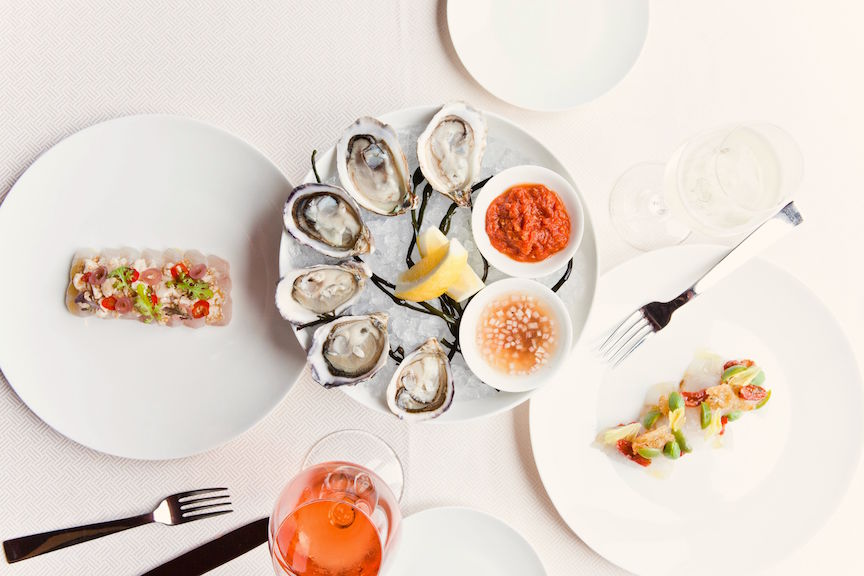 The
menu is not dissimilar to the majority of the
steakhouses in NYC, except that
Costata’s pastas are among the very best in the
city, as they would be
anywhere. Fusilli with
a
pork shoulder ragù, pomodoro
and robiolina
cheese ($22) is lusty and rich
in every morsel, the pasta impeccably al
dente; pansôti are
bulked up
with ricotta and mascarpone filling, corn purée
and red wine-laced sugo
($22); and garganelli alla fiamma, studded
with prosciutto and English peas,
in a lush truffle cream ($24) is irresistible to
the last bite.
The
menu is not dissimilar to the majority of the
steakhouses in NYC, except that
Costata’s pastas are among the very best in the
city, as they would be
anywhere. Fusilli with
a
pork shoulder ragù, pomodoro
and robiolina
cheese ($22) is lusty and rich
in every morsel, the pasta impeccably al
dente; pansôti are
bulked up
with ricotta and mascarpone filling, corn purée
and red wine-laced sugo
($22); and garganelli alla fiamma, studded
with prosciutto and English peas,
in a lush truffle cream ($24) is irresistible to
the last bite.
The menu is shorter than it
used to be—-no more
American “caviar” and no lamb chops.
For starters White reprises several of his
hits from other restaurants, including a
selection of crudi like lustrous amberjack
dolled up with Calabrian chilies and
pickled cauliflower ($19). A
half
dozen East Coast oysters served with mignonette
and spicy arrabbiata cocktail sauce ($18)
were good and briny, and a each
species in a fritto
misto of calamari,
halibut,
shrimp, artichokes with Calabrian chili aïoli
($19) was perfectly
cooked, crispy and hot. Beef
tartare with sauce gribiche,
pecorino, capers and thin croutons ($16) was
well seasoned and very good,
though the portion was a little smaller than
elsewhere in town.
Among the seafood items, a branzino of very meaty quality
with sweet heirloom
tomato, charred corn and sopresatta
($35) came together well, but the medium-sized
langoustines à la
plancha didn’t justify the price of
$19 a piece. The way to go here, of course, is
with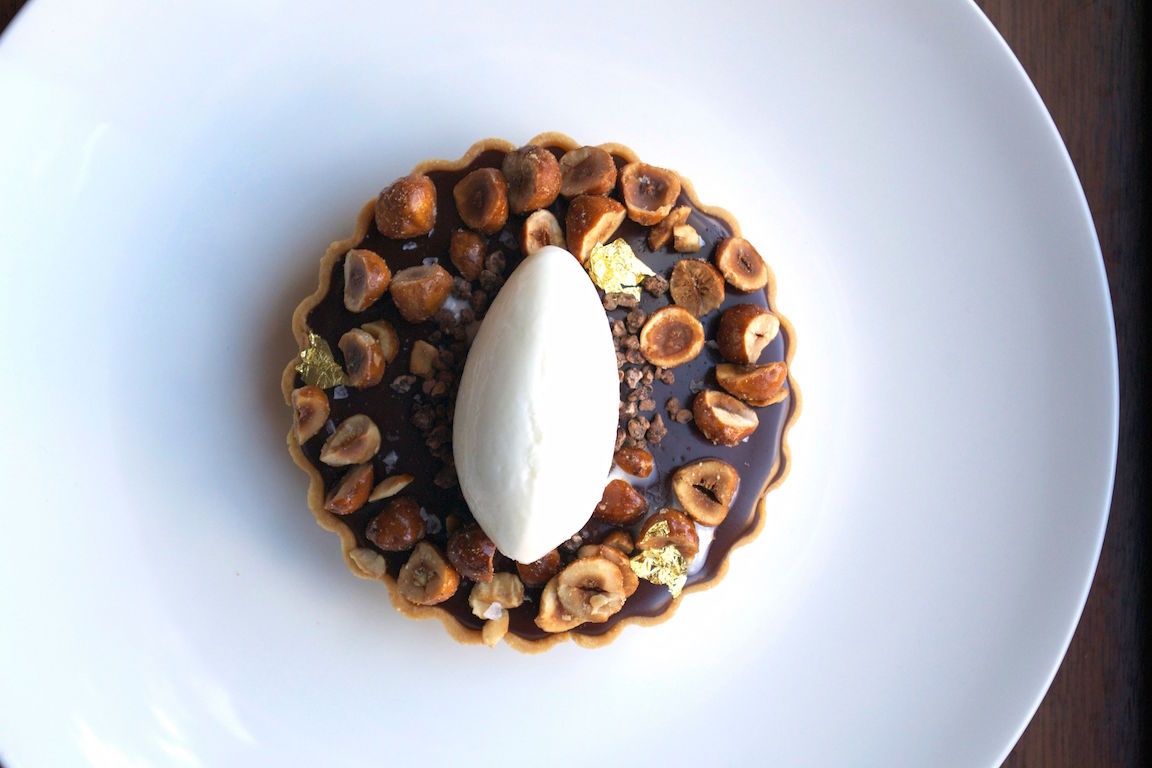 the
40-day dry-aged, 44-ounce costata
cut, in the U.S. often called a tomahawk steak
($126 for two, or more, people-—well
below the $145 côte de boeuf at Minetta Tavern).
We also enjoyed a 15-ounce New
York boneless strip ($43). The
black Angus beef was very good, though I’ve had
better marbleized steaks in NYC
and the char on the outside could be darker on
the costata.
the
40-day dry-aged, 44-ounce costata
cut, in the U.S. often called a tomahawk steak
($126 for two, or more, people-—well
below the $145 côte de boeuf at Minetta Tavern).
We also enjoyed a 15-ounce New
York boneless strip ($43). The
black Angus beef was very good, though I’ve had
better marbleized steaks in NYC
and the char on the outside could be darker on
the costata.
Side dishes are all
$9, and sauces are extra at
$4 each.
As with the pastas, Costata’s
desserts, by
Robert Truitt, are far above any of its
competitors’, including a first-rate crème
brûlée ($12), mascarpone torta ($12)
and affogato of strong coffee poured
over vanilla gelato with a shot of amaretto
($10). Gelati and
sorbetti
(three for $9) are also
delicious.
Given his far flung empire, your chances of seeing Michael
White on
premises are pretty slim, which is
understandable
but disappointing because he is a very
ebullient, spirited fellow who imbues
his restaurants with his presence.
Lacking that, Costata has a very affable
staff; our waitress, Mary, was
terrific on all counts.
So,
while there is no strong personality up front to
fill White’s chef’s clogs, this is now a much
better, more inviting steakhouse
than when it opened in 2013 and a clear
evolution of the New York Italian
steakhouse. Even if you just had a bowl of pasta
here, you’d think it was one
of the best Italian spots in town.
❖❖❖
TO ROBERT MONDAVI WINERY

In this era of the overly familiar, I
have
always been struck by the reverence with which
the name “Mr. Mondavi” is
invoked. Over the course of several days in the
Napa Valley this past spring,
on a trip hosted by the Robert Mondavi Winery
and with a focus on their own
wines as well as the wholly unique terroir of
the Oakville AVA, his name,
almost always preceded by a reverential
“Mister,” was uttered countless times.
That deeply felt respect, of
course, is
understandable, because it is impossible to talk
about the history of American
wine without mentioning Robert Mondavi (1913-2008)
as one of the most important catalysts
of this nation’s ascent to become the global wine
powerhouse it is today.
Indeed, precious few names around the world are as
synonymous with a particular
country’s wine industry as Mr. Mondavi’s is with
our own.
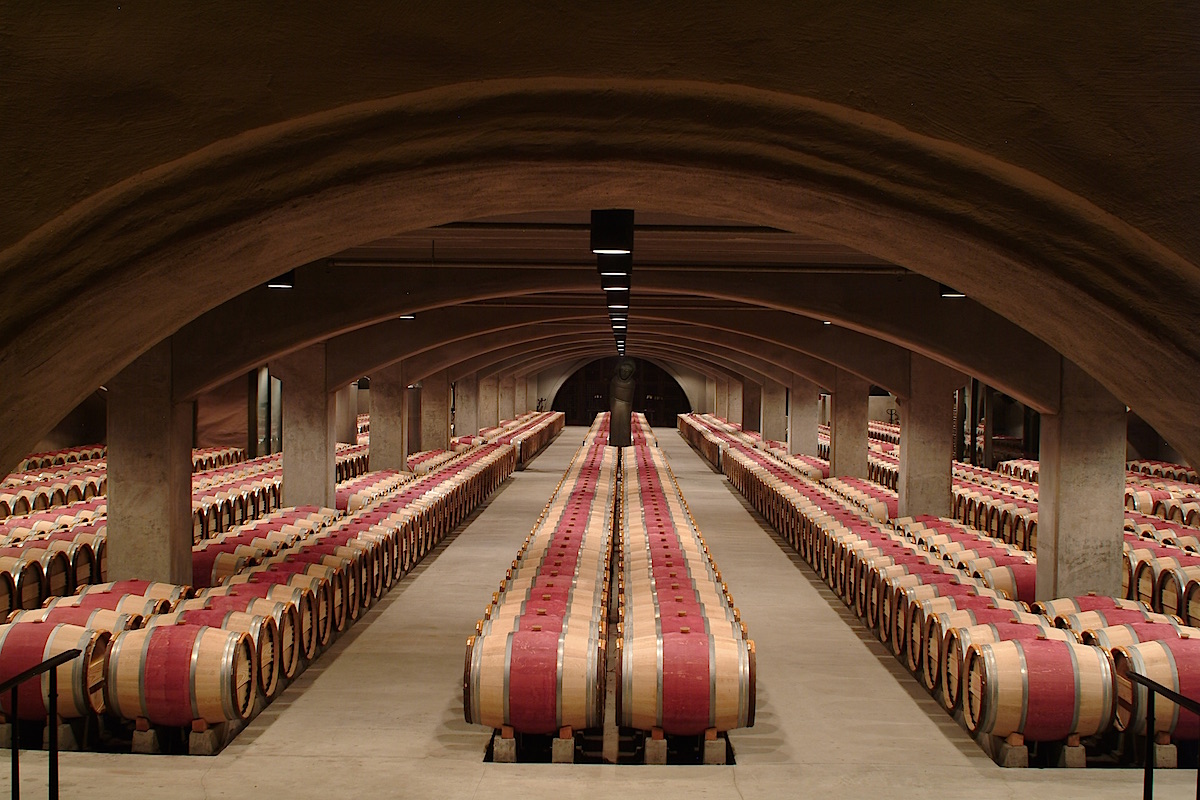 The
downside of Robert Mondavi Winery’s long,
successful
run is that occasionally, consumers not
well-versed in the various bottlings
bearing the Mondavi name, find themselves
confused, conflating, say, the
Mondavi Private Selection Cabernet Sauvignon with
Mondavi Cabernet Sauvignon Reserve.
(The difference between the two is difficult to
overstate, and while both more
than admirably achieve their individual aims,
those goals themselves are quite
different—the former to be a budget-friendly
bottling meant for immediate
consumption and the latter a deeply complex
expression of vintage and terroir,
and often one that benefits from extended time in
the cellar as it takes on
stunning layers of added complexity; Mr. Mondavi
himself spoke of this general
concern during his lifetime.)
The
downside of Robert Mondavi Winery’s long,
successful
run is that occasionally, consumers not
well-versed in the various bottlings
bearing the Mondavi name, find themselves
confused, conflating, say, the
Mondavi Private Selection Cabernet Sauvignon with
Mondavi Cabernet Sauvignon Reserve.
(The difference between the two is difficult to
overstate, and while both more
than admirably achieve their individual aims,
those goals themselves are quite
different—the former to be a budget-friendly
bottling meant for immediate
consumption and the latter a deeply complex
expression of vintage and terroir,
and often one that benefits from extended time in
the cellar as it takes on
stunning layers of added complexity; Mr. Mondavi
himself spoke of this general
concern during his lifetime.)
Any confusion, however, is
immediately
clarified as soon as a range of the higher-end RMW
bottlings is opened: They
remain deeply profound examples of all that Napa
can be and is, and beautiful
expressions of both the places of origin and the
vision of the team behind
them. (This
has been the case both before and after
Constellation Brands acquired The
Robert Mondavi Corporation in 2004, leaving the
winery without a Mondavi
A good example
of this is the most recent
release of the Cabernet Sauvignon Reserve, which,
in fact, marks an important
turning point in the legendary bottling: The 2011
is the first vintage of the
Reserve whose label bears the vineyard designation
of To-Kalon, as it’s crafted
entirely from fruit harvested from there. Indeed,
To-Kalon, in the Oakville
AVA, resides in the uppermost echelon of American
vineyards: Ask a dozen wine
professionals to name their top five favorite
vineyard sources for Cabernet
Sauvignon around the world, and I’d bet that
To-Kalon (which appropriately
means "highest beauty" or "most beautiful" in
ancient Greek) is
mentioned far more often than not.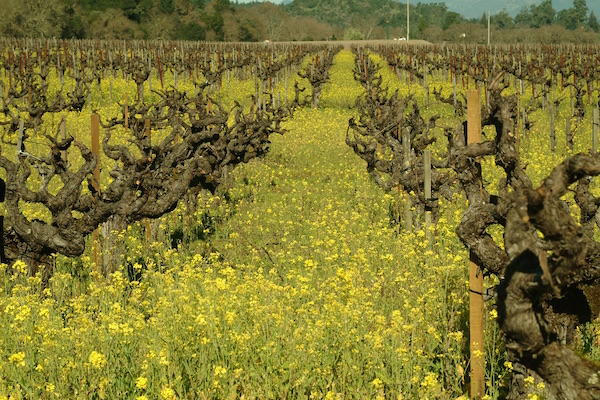
To-Kalon
has always been the primary source for
the Cabernet Sauvignon Reserve (as well as for the
Robert Mondavi Winery
Oakville Cabernet Sauvignon and the famously
expressive, deeply complex
To-Kalon I-Block Fumé Blanc), but 2011, with its
designation on the label, ties
RMW and the vineyard even closer among the
wine-drinking public. The result is
a wine of grace and pleasure, boasting aromas of
brambly purple berry fruit,
pencil led, cedar, spice, cassis, and a bit of
grilled sage. It’s young still
but in a fantastic place already, and against the
richness of the fruit, there
is also a nice sense of minerality and freshness,
marking both the quality of
the vineyard’s terroir and the nature of the
vintage. On the palate, this is
velvety in texture, and the purple berry fruit
from the nose comes through
clearly alongside flavors of graphite, cedar,
pencil led, tobacco leaf, coffee,
and grilled sage, all interwoven with elegance and
just enough power to keep on
pushing through to the finish tinged with violets,
raspberries, Chinese
five-spice, and eucalyptus. It’s a wine of
structure and richness in equal
measure that will continue to evolve for another
15-plus years.
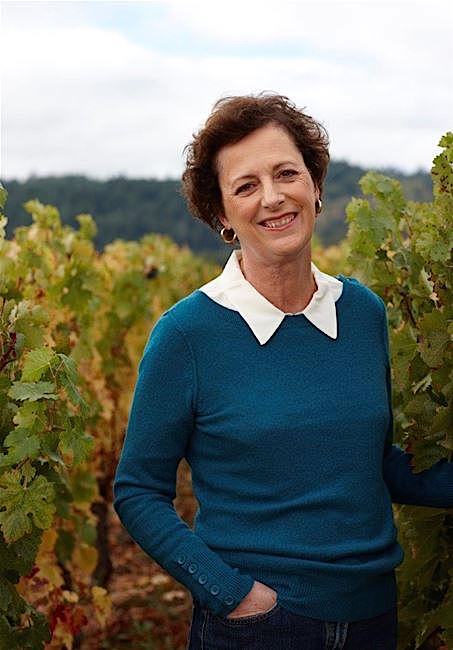 Of course,
a winery of Mondavi’s size and power
sources its fruit from other notable vineyard
sites as well, and under the
guidance and vision of Director of Winemaking
Geneviève Janssens (left), produces
notable bottlings from other grape varieties, and
in other styles, as well.
Among the crop of standout bottles from the winery
that I’ve tasted lately are
the Napa Valley Chardonnay 2011 with its lemon
oil, mushroom, and honey
aromatics that lead to a creamy palate zipped
through with lime, orange
blossom, apricot, and lemongrass; the Napa Valley
(Carneros) Pinot Noir 2012,
which rises from the glass with cherry cola, rose
petal, and sarsaparilla and
tastes beguilingly of cherry, red plum, and Middle
Eastern spices; the
Oakville-sourced Fumé Blanc 2013, with its
ambrosial nose of smoky apricots,
passionfruit, vanilla pod and mineral and its
bright flavors of lemongrass,
lime, and white tea; and the
Of course,
a winery of Mondavi’s size and power
sources its fruit from other notable vineyard
sites as well, and under the
guidance and vision of Director of Winemaking
Geneviève Janssens (left), produces
notable bottlings from other grape varieties, and
in other styles, as well.
Among the crop of standout bottles from the winery
that I’ve tasted lately are
the Napa Valley Chardonnay 2011 with its lemon
oil, mushroom, and honey
aromatics that lead to a creamy palate zipped
through with lime, orange
blossom, apricot, and lemongrass; the Napa Valley
(Carneros) Pinot Noir 2012,
which rises from the glass with cherry cola, rose
petal, and sarsaparilla and
tastes beguilingly of cherry, red plum, and Middle
Eastern spices; the
Oakville-sourced Fumé Blanc 2013, with its
ambrosial nose of smoky apricots,
passionfruit, vanilla pod and mineral and its
bright flavors of lemongrass,
lime, and white tea; and the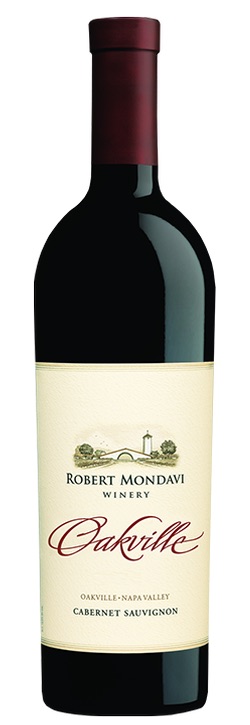 Oakville
Cabernet Sauvignon 2012 (below), a big wine at
15% alcohol that still maintains stellar balance
as it speaks of dark-cherry
liqueur, flowers, Fig Newtons, black licorice,
creme de cassis, charred sage,
baker’s chocolate and dried lavender.
Oakville
Cabernet Sauvignon 2012 (below), a big wine at
15% alcohol that still maintains stellar balance
as it speaks of dark-cherry
liqueur, flowers, Fig Newtons, black licorice,
creme de cassis, charred sage,
baker’s chocolate and dried lavender.
(I also recently had the
insanely good
fortune to taste the Robert Mondavi Unfiltered
Cabernet Sauvignon 1994 from my
father’s cellar, which was a gift from our good
friend Scot “Zippy” Ziskind of
Zipco Wine Cellar Services and My Cellar Wine
Storage, and was bowled over by
this fully mature beauty, its dried red currants,
tobacco leaf, eucalyptus and
wild mushroom aromas leading to a palate of
porcini dust, licorice root, spice
cake and violets. Other older bottlings of RMW’s
Cabernets and Reserve
Cabernets have been equally delicious: This is a
winery that knows how to craft
wines that age more than gracefully.)
Recently,
a bust of Robert Mondavi was
inaugurated on the iconic grounds of the winery,
and I was lucky enough to be
on hand this past spring to hear his widow, the
indefatigable Margrit Biever
Mondavi, who serves as Vice President of Cultural
Affairs, speak. The
sculpture, by artist Len Urso, is a fitting
tribute to a man who changed the
face of American wine, and whose namesake wines
continue to standout even
today, nearly 50 years after he founded the
winery. No wonder that honorific “Mister”
is used when referring to him. He deserves it more
than anyone.
❖❖❖
 JUST WHAT
WE'RE LOOKING
JUST WHAT
WE'RE LOOKING
FOR IN A WINE!
"In the
glass: Pop Crush white blend is a fine pale
citrine-yellow color with a light translucent core going
out into a watery meniscus showing a medium viscosity.
On the nose: There is a plethora of olfactory pleasers
led by honeydew melon, white peach, nectarine rind,
cornflowers, sweet aromatic white grape juice, lemon
balm and white tea."--Gil Lempert-Schwarz, "Pop Crush
White Blend," Las
Vegas Review Journal (7/25/15)

Scientists at Purdue say that
they've added a sixth sensation to the list of five
basics tastes (sour, salty, sweet, bitter, and umami),
and it is ... fat!
Purdue's researchers speculate that fat on the
tongue acts exactly like salty and sweet do as far
as people's perception of food. People can also
distinctly finger fatty as a taste apart from, say,
umami or bitter. "The combination of those two things,"
the lead researcher told the Washington Post,
"is what's important."
Any of John Mariani's books below may be ordered from amazon.com.
 I'm proud and happy to announce that my
new book, The Hound
in Heaven (21st Century Lion Books), has just
been published through Amazon and Kindle.
I'm proud and happy to announce that my
new book, The Hound
in Heaven (21st Century Lion Books), has just
been published through Amazon and Kindle. It is a novella, and for anyone who loves dogs, Christmas, romance, inspiration, even the supernatural, I hope you'll find this to be a treasured favorite. The story concerns how, after a New England teacher, his wife and their two daughters adopt a stray puppy found in their barn in northern Maine, their lives seem full of promise. But when tragedy strikes, their wonderful dog Lazarus and the spirit of Christmas are the only things that may bring back his master back from the edge of despair.
WATCH THE VIDEO!
“What a huge surprise turn this story took! I was completely stunned! I truly enjoyed this book and its message.” – Actress Ali MacGraw
“He had me at Page One. The amount of heart, human insight, soul searching, and deft literary strength that John Mariani pours into this airtight novella is vertigo-inducing. Perhaps ‘wow’ would be the best comment.” – James Dalessandro, author of Bohemian Heart and 1906.
“John Mariani’s Hound in Heaven starts with a well-painted portrayal of an American family, along with the requisite dog. A surprise event flips the action of the novel and captures us for a voyage leading to a hopeful and heart-warming message. A page turning, one sitting read, it’s the perfect antidote for the winter and promotion of holiday celebration.” – Ann Pearlman, author of The Christmas Cookie Club and A Gift for my Sister.
“John Mariani’s concise, achingly beautiful novella pulls a literary rabbit out of a hat – a mash-up of the cosmic and the intimate, the tragic and the heart-warming – a Christmas tale for all ages, and all faiths. Read it to your children, read it to yourself… but read it. Early and often. Highly recommended.” – Jay Bonansinga, New York Times bestselling author of Pinkerton’s War, The Sinking of The Eastland, and The Walking Dead: The Road To Woodbury.
“Amazing things happen when you open your heart to an animal. The Hound in Heaven delivers a powerful story of healing that is forged in the spiritual relationship between a man and his best friend. The book brings a message of hope that can enrich our images of family, love, and loss.” – Dr. Barbara Royal, author of The Royal Treatment.
 |
The Encyclopedia of American Food and Drink by John F. Mariani (Bloomsbury USA, $35) Modesty forbids me to praise my own new book, but let me proudly say that it is an extensive revision of the 4th edition that appeared more than a decade ago, before locavores, molecular cuisine, modernist cuisine, the Food Network and so much more, now included. Word origins have been completely updated, as have per capita consumption and production stats. Most important, for the first time since publication in the 1980s, the book includes more than 100 biographies of Americans who have changed the way we cook, eat and drink -- from Fannie Farmer and Julia Child to Robert Mondavi and Thomas Keller. "This book is amazing! It has entries for everything from `abalone' to `zwieback,' plus more than 500 recipes for classic American dishes and drinks."--Devra First, The Boston Globe. "Much needed in any kitchen library."--Bon Appetit. |
"Eating Italian will never be the same after reading John Mariani's entertaining and savory gastronomical history of the cuisine of Italy and how it won over appetites worldwide. . . . This book is such a tasteful narrative that it will literally make you hungry for Italian food and arouse your appetite for gastronomical history."--Don Oldenburg, USA Today. "Italian
restaurants--some good, some glitzy--far
outnumber their French rivals. Many of
these establishments are zestfully described
in How Italian Food Conquered the World, an
entertaining and fact-filled chronicle by
food-and-wine correspondent John F.
Mariani."--Aram Bakshian Jr., Wall Street
Journal.
"Equal parts
history, sociology, gastronomy, and just
plain fun, How Italian Food Conquered the
World tells the captivating and delicious
story of the (let's face it) everybody's
favorite cuisine with clarity, verve and
more than one surprise."--Colman Andrews,
editorial director of The Daily
Meal.com. "A fantastic and fascinating
read, covering everything from the influence
of Venice's spice trade to the impact of
Italian immigrants in America and the
evolution of alta cucina. This book will
serve as a terrific resource to anyone
interested in the real story of Italian
food."--Mary Ann Esposito, host of PBS-TV's
Ciao
Italia. "John Mariani has written the
definitive history of how Italians won their
way into our hearts, minds, and
stomachs. It's a story of pleasure over
pomp and taste over technique."--Danny Meyer,
owner of NYC restaurants Union Square
Cafe, The Modern, and Maialino.
|
 |
 |
 |
 |
 |
 |
 |
 |
 Everett Potter's Travel Report:
Everett Potter's Travel Report: 
 Eating Las
Vegas is the new on-line site for
Virtual Gourmet contributor John A. Curtas.,
who since 1995 has been commenting on the
Las Vegas food scene and reviewing
restaurants for Nevada Public Radio.
He is also the restaurant critic for KLAS
TV, Channel 8 in Las Vegas, and his past
reviews can be accessed at KNPR.org.
Click on the logo below to go directly to
his site.
Eating Las
Vegas is the new on-line site for
Virtual Gourmet contributor John A. Curtas.,
who since 1995 has been commenting on the
Las Vegas food scene and reviewing
restaurants for Nevada Public Radio.
He is also the restaurant critic for KLAS
TV, Channel 8 in Las Vegas, and his past
reviews can be accessed at KNPR.org.
Click on the logo below to go directly to
his site.

Tennis Resorts Online: A Critical Guide to the World's Best Tennis Resorts and Tennis Camps, published by ROGER COX, who has spent more than two decades writing about tennis travel, including a 17-year stretch for Tennis magazine. He has also written for Arthur Frommer's Budget Travel, New York Magazine, Travel & Leisure, Esquire, Money, USTA Magazine, Men's Journal, and The Robb Report. He has authored two books-The World's Best Tennis Vacations (Stephen Greene Press/Viking Penguin, 1990) and The Best Places to Stay in the Rockies (Houghton Mifflin, 1992 & 1994), and the Melbourne (Australia) chapter to the Wall Street Journal Business Guide to Cities of the Pacific Rim (Fodor's Travel Guides, 1991).


MARIANI'S VIRTUAL GOURMET
NEWSLETTER is published weekly. Editor/Publisher: John
Mariani.
Editor: Walter Bagley. Contributing Writers: Christopher Mariani,
Robert Mariani, Misha
Mariani,
John A. Curtas, Edward Brivio, Mort Hochstein,
Andrew Chalk, Dotty Griffith and Brian Freedman. Contributing
Photographers: Galina Dargery, Bobby
Pirillo. Technical Advisor: Gerry McLoughlin.
To un-subscribe from this newsletter,click here.
© copyright John Mariani 2015

